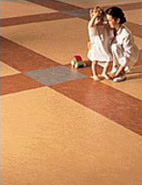
Sheet
vinyl, vinyl composition tile (VCT) or just about any kitchen
flooring is often referred to by the layman as linoleum. That’s
because throughout the years linoleum was the staple for kitchen
floors.
Linoleum is enjoying renewed popularity as a flooring choice
because it is made of natural ingredients, including linseed
oil, cork, limestone, wood flour and tree resins. The color
in linoleum goes all the way through, making it extremely durable.
Another reason for linoleum’s renaissance, while it normally
comes in sheets, it can be hand-cut for intricate patterning
and one of a kind artistry. Linoleum is a quiet, warm surface
that cushions your feet and requires minimal maintenance although
it may scuff or mark if not kept well polished.
Cork flooring can be a viable alternative for any room in the
home. It is a natural product, so even if finished in color or left natural,
it will show variations in characteristics, tones and shades from tile to tile.
Cork flooring is installed much like a hardwood floor in that once installed,
a urethane coating is applied. However, cork flooring is much warmer than wood
as well as being durable and forgiving.
Cork is actually the bark of a tree commonly known as Cork Oak. Predominantly
found in Portugal and Spain, Cork Oak is native to the Mediterranean region.
The bark naturally splits every 9 to 15 years and can be safely harvested causing
no harm to the tree. The bark re-grows and the cycle continues on for years
and years. Some Cork Oak trees have been known to live up to 500 years.
Cork flooring is not only warm to walk on and extremely quiet with natural
sound absorbing qualities, it is also naturally hypoallergenic and naturally
resistant to mold and mildew.
